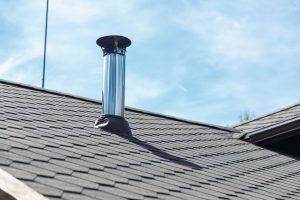As spring roars in like a lion in Northeast Ohio, homeowners should be sure to keep a keen eye out for common springtime roof issues that tend to crop up as warmer weather and soaking rains settle in. Powerful storms, heavy rains, and winter’s lingering moisture can create roofing issues that will be quite a headache if left unattended.
Trapped Moisture on the Roof
 Moisture that finds its way into your home and collects within your shingles or roof decking can cause a myriad of problems. Ice dams are one of the biggest sources for excess roof and attic moisture. Shingles damaged by heavy rains, hail, or loose debris allow moisture to leak under the roof to settle into the roof decking. Water vapors from inside the home (such as steam from cooking and showers) that collect in the attic due to improper ventilation are another common source of excess moisture underneath the roof. Very often, this excess moisture – regardless of the cause – collects in the insulation and roof decking in the attic, going unnoticed by the homeowner because it does not leak through to the living space. Once the moisture does leak through to the living space, the issues for the roof, roof decking, and attic are a nightmare to deal with.
Moisture that finds its way into your home and collects within your shingles or roof decking can cause a myriad of problems. Ice dams are one of the biggest sources for excess roof and attic moisture. Shingles damaged by heavy rains, hail, or loose debris allow moisture to leak under the roof to settle into the roof decking. Water vapors from inside the home (such as steam from cooking and showers) that collect in the attic due to improper ventilation are another common source of excess moisture underneath the roof. Very often, this excess moisture – regardless of the cause – collects in the insulation and roof decking in the attic, going unnoticed by the homeowner because it does not leak through to the living space. Once the moisture does leak through to the living space, the issues for the roof, roof decking, and attic are a nightmare to deal with.
The roof decking acts as a sponge for this excess moisture, causing it to expand and contract as moisture levels and temperatures fluctuate. The roof decking’s expansion and contraction can lead to cracked or distorted shingles, increasing the likelihood they too will begin absorbing the moisture. Excess moisture on the roof and roof decking severely limits the life of a roof. Anywhere excess moisture collects, mold and mildew tend to thrive and grow. Mold may collect on or underneath the shingles, on the roof decking, on the rafters, or within attic insulation. While mold and mildew can pose serious health risks for your loved ones, they also cause damage to your home’s structure by eating away at the surfaces upon which they collect, causing rot and degradation.
Damaged Roof Sealants and Flashing
 Winter in Northeast Ohio can be tricky to predict. We often see temperatures in January and February that can swing wildly from nearly zero degrees to sixty degrees in just one week. This constant rapid and extreme fluctuation in temperatures can have a devastating effect on building materials that are prone to expand and contract with these temperature changes. Roof sealants, among the most delicate materials that make up a roof, will eventually crack due to these changes in temperature, allowing water to seep underneath and begin eating away at the roof’s flashing. Roof flashing is a thin layer of galvanized metal that protects critical areas of your home’s roof by shielding them from water. It is often seen around chimneys, vents, skylights, or near joining walls. Flashing directs water away from these critical areas toward the gutters. However, if moisture begins collecting near the flashing, as it does when a sealant becomes cracked and allows moisture to seep in, the flashing will become damaged over time and be unable to protect these areas from moisture. Because the sealants are not visible from the ground, and because it takes such minimal damage to allow moisture to leak in, damaged or failing sealant is very difficult to identify before other damage to the flashing has occurred.
Winter in Northeast Ohio can be tricky to predict. We often see temperatures in January and February that can swing wildly from nearly zero degrees to sixty degrees in just one week. This constant rapid and extreme fluctuation in temperatures can have a devastating effect on building materials that are prone to expand and contract with these temperature changes. Roof sealants, among the most delicate materials that make up a roof, will eventually crack due to these changes in temperature, allowing water to seep underneath and begin eating away at the roof’s flashing. Roof flashing is a thin layer of galvanized metal that protects critical areas of your home’s roof by shielding them from water. It is often seen around chimneys, vents, skylights, or near joining walls. Flashing directs water away from these critical areas toward the gutters. However, if moisture begins collecting near the flashing, as it does when a sealant becomes cracked and allows moisture to seep in, the flashing will become damaged over time and be unable to protect these areas from moisture. Because the sealants are not visible from the ground, and because it takes such minimal damage to allow moisture to leak in, damaged or failing sealant is very difficult to identify before other damage to the flashing has occurred.
Curling, Damaged, or Missing Shingles

Shingles can suffer damage in the winter or springtime for many reasons. During the winter, like the other elements of the roof, fluctuations in temperatures will cause the shingles to expand and contract, leading to cracked or warped shingles, especially near the edges of the roof. Ice accumulation can cause the granules to be stripped off the shingles, and the added moisture from ice dams can cause the shingles to rot. In the spring, heavy thunderstorms can bring excessive rain, hail, damaging winds, and flying debris, all of which can wreak havoc on your roof’s shingles. In many cases, damage to the shingles from major storms will go unnoticed by homeowners who do not know the telltale signs of roof damage. Left unmitigated, these damaged areas can allow moisture to accumulate, which will eventually lead to mold, mildew, and rot.
The best way to be sure your roof is in good shape this spring – especially after the storms Northeast Ohio has already weathered – is to schedule an annual roof inspection. Aapex Construction & Restoration provides expert roof inspections to identify and offer solutions for all roofing issues, including ice dams, mold growth, leaks, and more. We work as your advocate, meticulously documenting all roofing issues to help you maximize any homeowner’s policy claim you may need to make while repairing your roof. Contact us today to schedule your springtime roof inspection and rest easy with peace of mind that these common springtime roof issues won’t create a headache for you later on.
Related Articles
The Causes of Roof Ice Dams and How to Prevent Them
The Importance of Proper Roof Ventilation
Hail Damage – What You Need to Know
Signs of Hidden Wind Storm Damage



I wasn’t aware that moisture can easily cause a lot of roof problems. It might also be the reason why some of our roofing shingles get broken weeks after experiencing heavy rainfall. It might be better to call roofing contractors for immediate repair service.